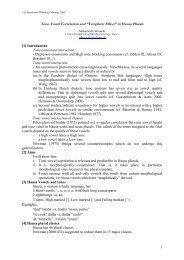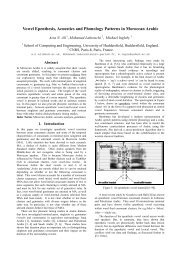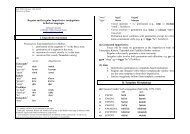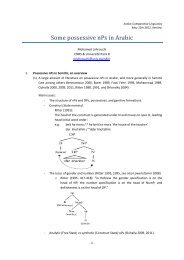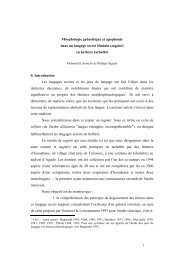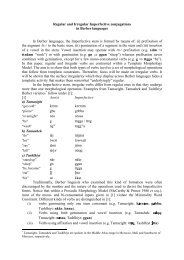Un principe de morphologie gabaritique
Un principe de morphologie gabaritique
Un principe de morphologie gabaritique
You also want an ePaper? Increase the reach of your titles
YUMPU automatically turns print PDFs into web optimized ePapers that Google loves.
tachelhitC 1 V C V C 2 V C 3 V| | |k S m[kSSSSm]C 1 V C V C 2 V C 3 V| | |f r d[ffrd](19) Analyse Bi- et monoconsonantiquesLe nombre <strong>de</strong>s opérations utilisées dépen<strong>de</strong>nt <strong>de</strong> la taille du radical ; plus la forme <strong>de</strong> base estcourte plus le nombre <strong>de</strong>s opérations utilisées pour former l'imperfectif est élevé.Mono- et bi- et triconsonantiques utilisent le même gabarit que les triconsonantiques pourformer leur imperfectif.(20)a) tamazightC V ⇒ C V C V C V C V| | | \ / \ /g t ´ g a[g][t´gga]C V C V ⇒ C V C V C V C V| | | | | \ / \ /n ´ s n ´ s a[n´s][n´ssa]b) kabyleC V C V ⇒ C V C V C V C V| \ / | | \ / |f i t s f a j[fi][t s faj]C V C V ⇒ C V C V C V C V| | | \ / \ / |g ´ r g a r[fi][ggar]c) tamacheqC V C V ⇒ C V C V C V C V| | |Q Z t A Z[Q$Q$Z][tA@A@ZZZZ]6
-(31) Deux conséquences- La corrélation tons/voyelles est morpholgiquement conditionnée dans les pluriels du haoussa.- Deux classes principales: (i) les pluriels <strong>gabaritique</strong>s comme ceux en (23) et (ii) les plurielsnon-<strong>gabaritique</strong>s majoritairement dérivés par alternance vocalique partiellement prédictible.(32) PCO et distribution tons / voyellesSi V2 haute alors V3 basse (u-a) et si V2 basse alors V3 haute (a-i, a-e).De même si ton Bas sur la secon<strong>de</strong> syllabe alors ton Haut sur la syllabe suivante et si ton Hautle ton suivant est Bas.9
Références <strong>de</strong> baseBarillot, X. 2002. Morphophonologie <strong>gabaritique</strong> et information consonantique en somali et dansles langues est-couchitiques. Thèse <strong>de</strong> Doctorat, <strong>Un</strong>iversité Paris 7.Bat-El, O. 1994. Stem modification and cluster transfer in Mo<strong>de</strong>rn Hebrew. Natural Language andLinguistic Theory 12:571-596.Bendjaballah, S. 2001. The « Negative Preterit » in Kabyle Berber. Folia Linguistica XXXIV/3-4 :185-220.Dell, F. & M. Elmedlaoui. 1988. Syllabic Consonants in Berber: Some New Evi<strong>de</strong>nce. Journal ofAfrican Languages and Linguistics 10, 1-17.Guerssel, M. & Lowenstamm, J. 1990. The Derivational Morphology of the Classical ArabicVerbal System. ms. UQAM & <strong>Un</strong>iversité Paris 7.Goldsmith, J. 1976. Autosegmental phonology. Cambridge, Mass.: MIT Ph. D. Dissertation.Distributed by Indiana <strong>Un</strong>iversity Linguistics Club. Published by Garland Press. New York.Idrissi, A. 2000. On Berber plurals. In J. Lecarme, J. Lowenstamm & U. Shlonsky (Eds.), Researchin Afroasiatic Grammar, Benjamins, Amsterdam.Kihm, A. 2003. Les pluriels internes <strong>de</strong> l’arabe : système et conséquences pour l’architecture <strong>de</strong> lagrammaire. Recherches Linguistiques <strong>de</strong> Vincennes, n° 32 : 109-156.Leben, William. 1978. The representation of tone. In V. Fromkin (ed.), Tone: A Linguistic Survey.New York: Aca<strong>de</strong>mic Press, 177-219.Lowenstamm, J. 1996. CV as the only syllable type. In. J. Durand & B. Laks (Eds.), Current Trendsin Phonology : Mo<strong>de</strong>ls and Methods: 419-441. CNRS, ESRI, Paris X.McCarthy, J. and A. Prince (1986) Prosodic Morphology, ms. <strong>Un</strong>iv. of Massachusetts and Bran<strong>de</strong>is<strong>Un</strong>iv.McCarthy, J. 1979. Formal problems in Semitic phonology and morphology. PhD dissertation,MIT, distributed by Indiana <strong>Un</strong>iversity Linguistics Club, Garland Press. New York.Newman, P. 1975. The Non-Correlation of Tone and Vowel Height in Hausa [July 1975]. Studies inAfrican Linguistics, Volume 6, Number 2: 207-13.Pilszczikowa-Chodak, N. 1975. On the Correlation of Tone and Vowel Height in Hausa: a Replayto Newman. [December 1975]. Studies in African Linguistics, Volume 6, Number 3: 315-321.Ratcliffe, R. 1988. The “broken” plural problem in Arabic and comparative Semitic: allomorphyand analogy in non-concatenative morphology. Amsterdam/Phila<strong>de</strong>lphia: Benjamins.Ségéral, Ph. 2000. Théorie <strong>de</strong> l’apophonie et organisation <strong>de</strong>s schèmes en sémitique. Research inAfroasiatic Grammar, edited by Jacqueline Lecarme, Jean Lowenstamm & Ur Shlonsky, 263-299. Amsterdam & Phila<strong>de</strong>lphia: Benjamins.Ussishkin, Adam. 2000. The Emergence of Fixed Prosody. Ph.D. dissertation, <strong>Un</strong>iversity ofCalifornia, Santa Cruz.10
IV. Taqjmit: un langage secret fémininberbère(33) Donnéestachelhittaqjmita. 1 f r ħ t i f f a r ħ j u r ħ « sois heureux! »2 kSm t i k k a Sm j u Sm « entre ! »3 k r z t i k k a r z j u r z « laboure ! »4 ħ m a d t i ħ ħ a m d j u m d nom propre5 m b a r k t i b b a r k j u r k id.6 l a x b a r t i x x a b r j u b r « informations »7 s a d m r t i s s a d m r j u m r « réponse »8 k l t u m t i k k a t m j u t m nom propreb. 9 f i s s t i f f a s j u s i « tais-toi ! »10 g n t i g g a n j u n i « dors !»11 i g r t i g g a r j u r i « champs »12 t i g m m i t i g g a m j u m i « maison »13 t a ħ a n u t t i ħ ħ a n j u n i «chambre »14 f a t i m t i f f a t j u t i nom propre15 ÷iSa t i ÷ ÷ aSj u Si id.c. 16 g t i g g a w i w i « sois ! »17 i n i t i n n a w i w i « dis ! »18 t n n i t t i n n a w i w i « tu as dit »19 a f t i f f a w i w i « trouve ! »20 z r t i z z a r w i w i « regar<strong>de</strong> !»21 i b b a t i b b a w i w i « mon père »22 a s i t i s s a w i w i « prends ! »23 d d u t i d d a w i w i « pars ! »taqjmit ne conserve <strong>de</strong> l’information consonantique <strong>de</strong> la forme-source que :- l’information radicale,- trois consonnes maximalement.Stricte correspondance entre le nombre <strong>de</strong> consonnes radicales et le schème utilisé :a. 3 consonnes radicales => schème [33a] t i C1 C1 a C2 C3 j u C2 C3b. 2 consonnes radicales => schème [33b] t i C1 C1 a C2 j u C2 ic. 1 consonne radicale => schème [33c] (excepté ex. 20) t i C1 C1 a w i w i(34) Observation principaleChaque consonne radicale est répétée <strong>de</strong>ux fois dans la forme déguisée(35) Autres observationsa. préfixation <strong>de</strong> ti- tous les schèmesb. infixation <strong>de</strong> –ju- après la première C3 en [33a] / après la première C2 in [33b]c. suffixation <strong>de</strong> –i [33b]d. suffixation <strong>de</strong> –wiwi [33c]12
(36) Gabarit triconsonantiquesa) répétition du genregenre x 2 (« F » ⇒ « M »)k S mtI| |C C C C Cb) répétition gabaritC C C C C C C Cc) répétition consonnes radicales(37) Répéter toutt k S m I| | | | |C V C V C V C V C V C VLa représentation qui suit regroupe ces différentes opérations :[F ⇒ M]k S mtI| |C V C V C V C V C V C V C V C V C V C V"F""M"Tout est répété strictement <strong>de</strong>ux fois:le gabaritle genreles consonnes radicale(38) Biconsonantiquesgn ⇒ tigganjunj(> [tigganjuni])g ntI| =C V C V C V C V C V C V C V C V C V C VI A U13
(39) Monoconsonantiquesg ⇒ tiggawjwj(> [tiggawiwi])gtI|C V C V C V C V C V C V C V C V C V C VI A U14



